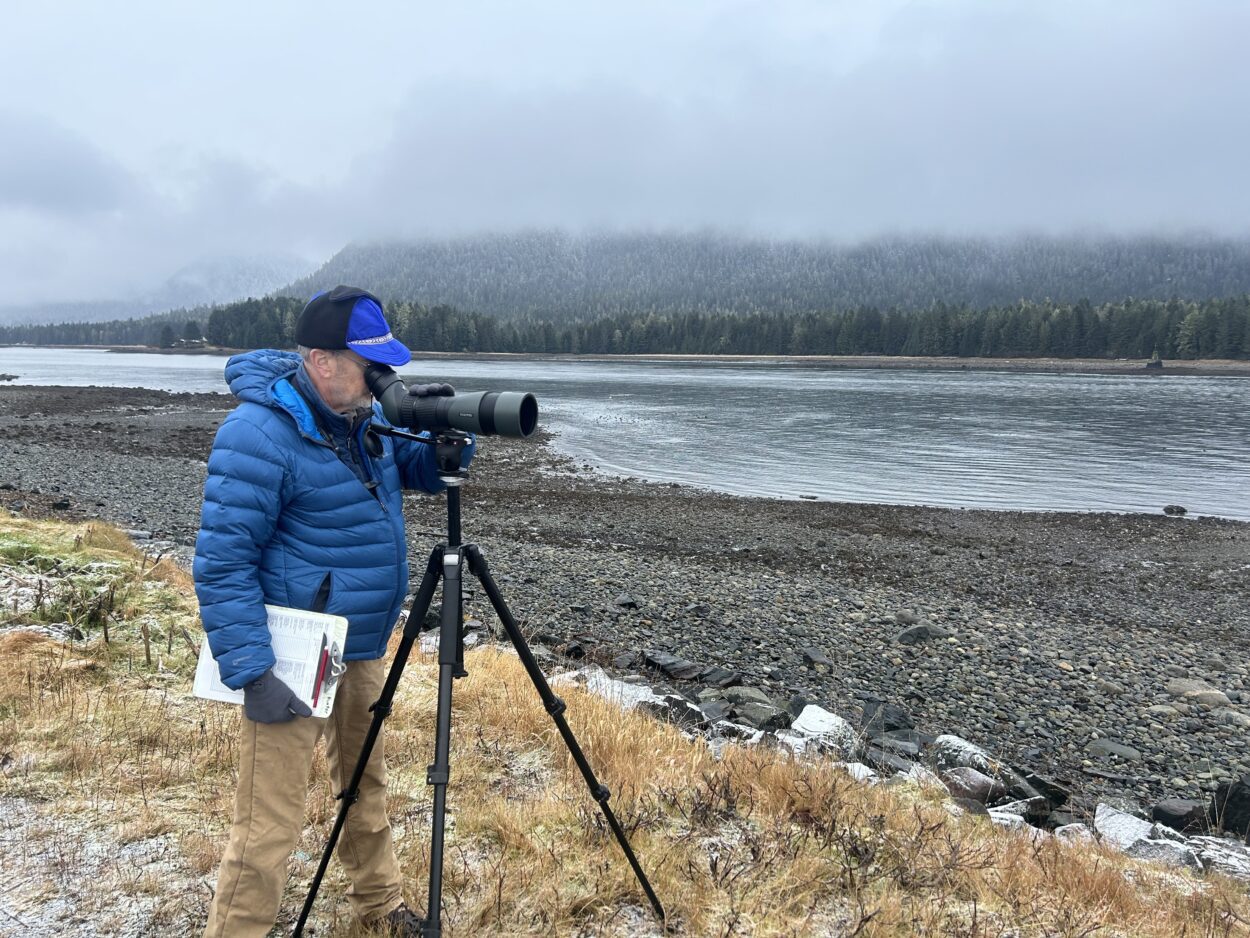
(Photo by Shelby Herbert/KFSK)
Petersburg birdwatchers cataloged scores of birds for the Audubon Society’s Christmas Bird Count, an annual citizen science inventory of birds across North America.
As KFSK’s Shelby Herbert reports, the island community counted the most birds in recent memory.
Splinters of sunlight pierced the morning mist at Hungry Point, a recreation spot on Petersburg’s northern coast. A flock of scoters bobbed in the surf. They’re large dark sea ducks with white markings around their faces. Brad Hunter had his spotting scope trained on them.
“So, there’s three species of scooters: surf, white wing, and black,” said Hunter. “The first two are the most predominant ones we have here — but the black ones are the ones that talk the most. So you know they’re out there because you hear them.”
Hunter didn’t need his sophisticated lens — or even his eyes — to know what types of birds are around him. He can identify many species in the region by sound alone.
“Actually being able to hear the birds is a huge part of identifying what species are out there,” said Hunter. “Visually seeing them is a big part, of course, but when you hear their call, hear their song — it’s very important.”
…Even when that song gets interrupted by other wildlife. Sea lions intermittently barked over the scoter calls.
Hunter has compiled Mitkof Island’s Christmas Bird Count data for the Audubon Society since the mid-90s. He said the group of about a dozen Petersburg birders had a remarkable inventory this year. Hunter is still finalizing the numbers, but by his latest figure, the group tallied a little over 9,000 birds around the island — and that was all in one day.
“I think it’s interesting,” said Hunter. “It’s notable!”
It’s not just the quantity that has Hunter so excited. The group also spotted an exceptional number of species at this year’s count: 61, over their previous high of 57. Hunter said the air was thick with uncommon seabirds this year.
“There’s also some seabirds that are still here,” said Hunter. “We typically do not get Bonaparte gulls on the Christmas Bird Count. But this year, we had quite a few of them.”
He doesn’t know why there were so many birds out and about this winter. But his best guess is that recent warm weather might play a part.
“We suspect that some of the birds that would have headed on South if ice had formed, and lakes and ponds were frozen over,” said Hunter. “[But] they have stayed around longer than normal.”
The climate pattern known as El Niño is cycling warmer water through Southeast Alaska. The resulting unseasonably calm weather is also making it easier for Petersburg’s birdwatchers to stay out longer. Hunter said his group has braved much worse conditions for the count in previous years.
“We’ve had so many terrible weather days for Christmas Bird Count,” said Hunter. “It’s hard to pick one of them out as the worst… But we’ve had some pretty bad ones where it’s blowing 30, 40, and snowing mixed in with rain. Or the roads are all icy, and deep snow — it can be challenging some years.”
Fair weather or not, Hunter said the count is important to him. And that’s because the data birdwatchers collect will help scientists better understand how bird populations are changing — and, eventually, how to better protect them. He said the process of learning about regional birds is also meaningful to him.
“I just find it interesting, just to keep growing and challenging myself and learning more about them — and especially learning about them around here,” said Hunter. “Some people travel all over the world to see how many species they can find. My challenge to myself is to see how many I can find around home.”
That’s what keeps him coming back, year after year.
The Audubon Society will finalize its data from the 124th annual Christmas Bird Count on January 5th, 2024.











